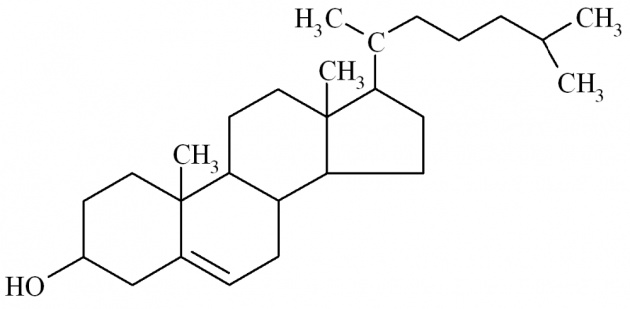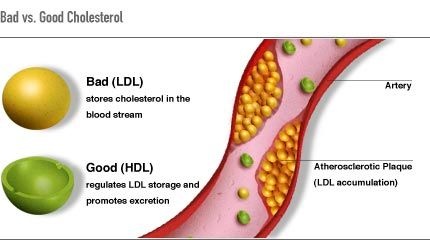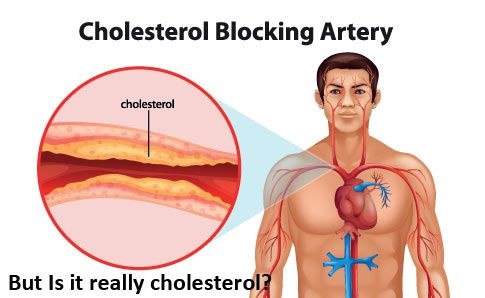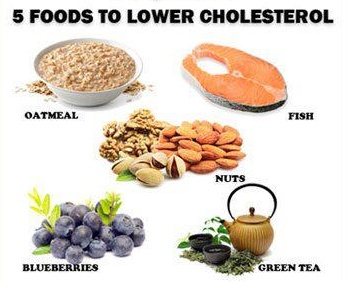Everybody of us have heard about the word cholesterol. When we are small kids , we hear this word quite often when our elders discuss about it. Today I decided to write about it. So friends let us share some important knowledge about cholestrol here. The fisst question most of us do not know is what is cholestrol. So we start with this basic question here. There are certain myths that cholesterol is always bad but it is not 100% true.
Dr. Jonny Bowden "The Great Cholesterol Myth"
 What is cholesterol?
What is cholesterol?
Cholesterol is found in every cell of the body and has important natural functions.Without it our life is not posible.Your body needs some cholesterol, but not too much. It is manufactured by the body but can also be taken in from food. It is waxy and fat-like in appearance.
A surplus can cause plaque to build up in your arteries and make it hard for blood to get to your heart. That can cause chest pain, called angina. If the blood supply is completely blocked, you will have a heart attack.It si the main reason of heart attacks in modern days. So awareness about cholestrol is really very very important.
There are different types of cholesterol. You want to lower the “bad” kind, LDL, and triglycerides, which your body stores in fat cells.
On the other hand, you want to raise your “good” (HDL) cholesterol. It helps get rid of the bad kinds.
Cholesterol is oil-based and so does not mix with the blood, which is water-based. It is therefore carried around the body in the blood by lipoproteins.
The parcels of cholesterol are carried by two types of lipoprotein:
- Low-density lipoprotein (LDL - cholesterol carried by this type is known as 'bad' cholesterol)
- High-density lipoprotein (HDL - cholesterol carried by this type is known as 'good' cholesterol).

Cholesterol has four main functions, without which we could not live. It:
- Contributes to the structure of cell walls
- Makes up digestive bile acids in the intestine
- Allows the body to produce vitamin D
- Enables the body to make certain hormones.
Fast facts on cholesterol
Here are some key facts about cholesterol. Find more detail and supporting information in the article.
- Cholesterol is an essential substance that is produced by the body but is also ingested from animal-derived foods.
- The greatest risk factors for high cholesterol are modifiable lifestyle choices - diet and exercise.
- A predisposition for high cholesterol levels can be inherited through the genetic condition, familial hypercholesterolemia.
- Having high cholesterol does not produce any symptoms in itself.
- Everyone should have their blood cholesterol levels tested once every 5 years.
- First-line ways to reduce cholesterol involve lifestyle changes.
- If lifestyle changes are unsuccessful or cholesterol levels are very high, lipid-lowering drugs such as statins may be prescribed.
- High cholesterol levels are an important contributor in the calculation of an individual's risk of having aheart attack within the next ten years.

Cholesterol diet
The support charity for people with high cholesterol, HEART UK, has identified "six super foods" that actively lower cholesterol levels:
- Soya foods (15g a day) - soya milk, soya desserts, soya meat alternatives, soya nuts, edamame beans and tofu
- Nuts - a handful a day
- Oats and barley - providing the soluble fiber beta glucan
- Plant sterols/stanols - found in a wide range of foods
- Fruits and vegetables
- Foods rich in unsaturated fats - for example, canola and vegetable oils.
Go to the charity's website for more information about foods that are good for cholesterol levels. HEART UK also lists foods that are bad for cholesterol levels:
- Butter
- Ghee
- Hard margarines
- Lard
- Fatty and processed meat
- Dairy fats. What is Cholesterol - How To Reduce Cholesterol Naturally
What causes high cholesterol?
High cholesterol is a major risk factor for coronary heart disease, a cause of heart attacks, and reducing blood lipid levels lowers the cardiovascular risk.
High levels of LDL lead to a build-up of cholesterol in the arteries, whereas HDL carries cholesterol to the liver for removal from the body. A build-up of cholesterol is part of the process that narrows arteries, calledatherosclerosis, in which plaques form and cause restriction of blood flow.
High cholesterol levels are a result of modifiable and non-modifiable risk factors. Two major risk factors, diet and exercise, are highly modifiable, meaning that something can be done to change these risk factors and reduce the likelihood of having high cholesterol.
Limiting intake of fat in the diet helps manage cholesterol levels. In particular, it is helpful to limit foods that contain:


Meat, cheese and egg yolks are sources of cholesterol.- Cholesterol (from animal foods, such as egg yolks, meat and cheese)
- Saturated fat (found in some meats, dairy products, chocolate, baked goods, and deep-fried and processed foods)
- Trans fat (found in some fried and processed foods).
Being overweight or obese can also lead to higher blood LDL levels, with regular exercise helpful in managing this risk factor.
The primary causes of high cholesterol are genetic - very high LDL levels are found in the inherited condition familial hypercholesterolemia.
Abnormal cholesterol levels may also be secondary to the following:
- Diabetes
- Liver or kidney disease
- Polycystic ovary syndrome
- Pregnancy and other conditions that increase levels of female hormones
- Underactive thyroid gland.
- Drugs that increase LDL cholesterol and decrease HDL cholesterol (progestins, anabolic steroids and corticosteroids).
Signs and symptoms of high cholesterol
Having high cholesterol levels, while a risk factor for other conditions, does not itself present any signs or symptoms. Unless routinely screened through regular blood testing, high cholesterol levels will go unnoticed and could present a silent threat of heart attack or stroke.
Signs and symptoms of high cholesterol
Having high cholesterol levels, while a risk factor for other conditions, does not itself present any signs or symptoms. Unless routinely screened through regular blood testing, high cholesterol levels will go unnoticed and could present a silent threat of heart attack or stroke.
Cholesterol tests and diagnosis
High cholesterol can only be diagnosed by blood testing. Doctors' guidelines state that everyone over the age of 20 years should have their cholesterol levels checked once every five years.
The cholesterol test is done after a period of fasting - no food, drink or pills for 9 to 12 hours - to enable an accurate reading of LDL cholesterol from the blood test. The screening also gives information about total cholesterol, HDL cholesterol and triglyceride levels.
The guidelines set cholesterol levels that help determine the individual heart risk, as follows:
LDL cholesterol
- Optimal: less than 100 mg/dL
- Near-optimal: 100 to 129 mg/dL
- Borderline high: 130 to 159 mg/dL
- High: 160 to 189 mg/dL
- Very high: 190 mg/dL and above.
Guidance is also set out for the other measures in the lipid profile:
Total cholesterol
- Desirable: less than 200 mg/dL
- Borderline high: between 200-239 mg/dL
- High: 240 mg/dL or above.
HDL cholesterol
- Low: below 40 mg/dL
- High: 60 mg/dL or above.
After more than a decade of recommendations that physicians treat patients in an attempt to lower cholesterol to less than 100mg/dL or less than 70mg/dL, new guidelines from the American College of Cardiology (ACC) and American Heart Association (AHA), developed with the National Heart, Lung, and Blood Institute (NHLBI) abandon this idea of LDL- and non-HDL-cholesterol targets.
There is no evidence from randomized, controlled clinical trials to support treatment to a specific target. So, instead of physicians prescribing numerous medications simply for the sake of reducing cholesterol levels, even when patients have no other risk factors for heart disease, the new guidelines recommend that physicians identify four groups of patients who are likely to benefit from statin treatment to better prevent primary and secondary cardiovascular events:9
- People with clinical atherosclerotic cardiovascular disease
- People who have LDL-cholesterol levels over 190 mg/dL, such as those with familial hypercholesterolemia
- People aged 40 to 75 years old with diabetes and LDL-cholesterol levels of 70-189 mg/dL and with no evidence of atherosclerotic cardiovascular disease
- People without evidence of cardiovascular disease or diabetes but who have LDL-cholesterol levels of 70-189 mg/dL and a 10-year risk of atherosclerotic cardiovascular disease greater than 7.5%.
Treatment and prevention of high cholesterol
Four changes to lifestyle are recommended for all people with high cholesterol levels - including those receiving drug treatment - in order to reduce the risk of coronary heart disease and heart attack:

Exercise is one lifestyle measure that can reduce cholesterol levels.- Eat a 'heart-healthy diet' (for example, use low-fat toppings and sauces, and avoid foods high in saturated fat; eat vegetables, fruits and fiber-rich whole grains)
- Take regular exercise
- Avoid smoking
- Achieve and maintain a healthy weight.
Lipid-lowering therapy
The lipid-lowering goal of drug treatment for an individual with hypercholesterolemia will depend on their individual cholesterol level and other risk factors, but statin treatment is generally reserved for people with a higher risk of heart attack, and diet and exercise are the first line in lipid-lowering therapy.
The cholesterol levels at which diet and exercise intervention is recommended range between 100 mg/dL and 160 mg/dL - the lower level when other risk factors are present.
Cholesterol-lowering drugs such as statins are recommended, depending on the overall heart risk, when cholesterol levels are between 130 mg/dL and 190 mg/dL.
Statins (also known as HMG CoA reductase inhibitors) are the main group of cholesterol-lowering drugs; the others are selective cholesterol absorption inhibitors, resins, fibrates and niacin.
The statins available on prescription in the US include:
- Atorvastatin (brand named Lipitor)
- Fluvastatin (Lescol)
- Lovastatin (Mevacor, Altoprev)
- Pravastatin (Pravachol)
- Rosuvastatin calcium (Crestor)
- Simvastatin (Zocor).
Statin safety
The prescription of statins has caused considerable debate in the medical community in recent years, with increased understanding of the side effects associated with these drugs.
While many patients benefit greatly from statin use to lower cholesterol and reduce their risk of heart attack, a significant number of patients also experience significant adverse effects from statins, including statin-induced myopathy and fatigue, as well as a greater risk of diabetes and diabetes complications. Evidence from observational studies indicates that some 10-15% of statin users develop statin-related muscle side effects, such as myalgia and myopathy.
In one recent study, researchers looked at data from 25,970 healthy adults to find 3,351 statin users and 3,351 nonusers and found that during the follow-up period of around 6.5 years 14% of patients developed diabetes, a figure similar to national trends10. Interestingly, though, those who took statins had an 85% higher risk of developing diabetes and two and a half times the risk of diabetes with complications, as well as a 12% increase in the likelihood of being overweight or obese compared with those who didn't take statins.
In the same study, patients taking high-intensity statin drugs had the greatest risk of diabetes (2.55 times the odds ratio), diabetic complications (3.68 times the odds ratio), and overweight/obesity (1.58 times the odds ratio).
Statin drugs that work by inhibiting the enzyme HMG CoA reductase also adversely affect the body's production of co-enzyme Q10, an important component of energy production in the muscles and brain. In fact, co-Q10 is concentrated in the heart muscle, with low levels of this antioxidant nutrient thought to adversely affect heart health.
The effect of statins on co-Q10 synthesis, and the synthesis of vitamin D (which relies on cholesterol production), are associated with muscle pain and soreness, and fatigue. Switching to a different statin medication, or increasing efforts to reduce cholesterol through lifestyle changes may help relieve statin-induced myopathy and other unwanted effects of these medications.
Ten-year risk of a heart attack
Cholesterol levels play a major part in an individual's risk of having a heart attack within the next ten years. The National Heart, Lung and Blood Institute provide an online calculator of cardiovascular risk. Using research evidence, it weighs the risk dictated by these factors:
- Age
- Sex
- Cholesterol levels
- Smoking status
- Blood pressure.
Monitoring the ten-year risk according to data from the Framingham Heart Study, which continues today, helps in the management of lifestyle and other measures to reduce cholesterol levels, and so cut the chances of cardiovascular disease leading to heart attack or stroke.



